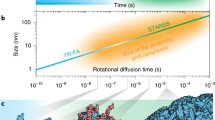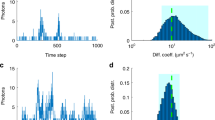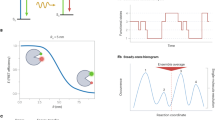Abstract
To understand the function of cellular protein networks, spatial and temporal context is essential. Fluorescence correlation spectroscopy (FCS) is a single-molecule method to study the abundance, mobility and interactions of fluorescence-labeled biomolecules in living cells. However, manual acquisition and analysis procedures have restricted live-cell FCS to short-term experiments of a few proteins. Here, we present high-throughput (HT)-FCS, which automates screening and time-lapse acquisition of FCS data at specific subcellular locations and subsequent data analysis1,2. We demonstrate its utility by studying the dynamics of 53 nuclear proteins3,4. We made 60,000 measurements in 10,000 living human cells, to obtain biophysical parameters that allowed us to classify proteins according to their chromatin binding and complex formation. We also analyzed the cell-cycle-dependent dynamics of the mitotic kinase complex Aurora B/INCENP5 and showed how a rise in Aurora concentration triggers two-step complex formation. We expect that throughput and robustness will make HT-FCS a broadly applicable technology for characterizing protein network dynamics in cells.
This is a preview of subscription content, access via your institution
Access options
Subscribe to this journal
Receive 12 print issues and online access
$209.00 per year
only $17.42 per issue
Buy this article
- Purchase on Springer Link
- Instant access to full article PDF
Prices may be subject to local taxes which are calculated during checkout



Similar content being viewed by others
References
Digman, M.A. & Gratton, E. Lessons in fluctuation correlation spectroscopy. Annu. Rev. Phys. Chem. 62, 645–668 (2011).
Weidemann, T. & Schwille, P. Dual-color fluorescence cross-correlation spectroscopy with continuous laser excitation in a confocal setup. Methods Enzymol. 518, 43–70 (2013).
Simpson, J.C., Neubrand, V.E., Wiemann, S. & Pepperkok, R. Illuminating the human genome. Histochem. Cell Biol. 115, 23–29 (2001).
Simpson, J.C., Wellenreuther, R., Poustka, A., Pepperkok, R. & Wiemann, S. Systematic subcellular localization of novel proteins identified by large-scale cDNA sequencing. EMBO Rep. 1, 287–292 (2000).
Honda, R., Korner, R. & Nigg, E.A. Exploring the functional interactions between Aurora B, INCENP, and survivin in mitosis. Mol. Biol. Cell 14, 3325–3341 (2003).
Mahen, R. et al. Comparative assessment of fluorescent transgene methods for quantitative imaging in human cells. Mol. Biol. Cell 25, 3610–3618 (2014).
Axelrod, D., Koppel, D.E., Schlessinger, J., Elson, E. & Webb, W.W. Mobility measurement by analysis of fluorescence photobleaching recovery kinetics. Biophys. J. 16, 1055–1069 (1976).
Elson, E.L. & Magde, D. Fluorescence correlation spectroscopy. I Conceptual basis and theory. Biopolymers 13, 1–27 (1974).
Stryer, L. Fluorescence energy transfer as a spectroscopic ruler. Annu. Rev. Biochem. 47, 819–846 (1978).
Schwille, P., Meyer-Almes, F.J. & Rigler, R. Dual-color fluorescence cross-correlation spectroscopy for multicomponent diffusional analysis in solution. Biophys. J. 72, 1878–1886 (1997).
Weidemann, T. et al. Counting nucleosomes in living cells with a combination of fluorescence correlation spectroscopy and confocal imaging. J. Mol. Biol. 334, 229–240 (2003).
Schmidt, U. et al. Assembly and mobility of exon-exon junction complexes in living cells. RNA 15, 862–876 (2009).
Kaur, G. et al. Probing transcription factor diffusion dynamics in the living mammalian embryo with photoactivatable fluorescence correlation spectroscopy. Nat. Commun. 4, 1637 (2013).
Müller, K.P. et al. Multiscale analysis of dynamics and interactions of heterochromatin protein 1 by fluorescence fluctuation microscopy. Biophys. J. 97, 2876–2885 (2009).
Yu, S.R. et al. Fgf8 morphogen gradient forms by a source-sink mechanism with freely diffusing molecules. Nature 461, 533–536 (2009).
Ries, J. et al. Automated suppression of sample-related artifacts in Fluorescence Correlation Spectroscopy. Opt. Express 18, 11073–11082 (2010).
Carpenter, A.E. & Sabatini, D.M. Systematic genome-wide screens of gene function. Nat. Rev. Genet. 5, 11–22 (2004).
Pepperkok, R. & Ellenberg, J. High-throughput fluorescence microscopy for systems biology. Nat. Rev. Mol. Cell Biol. 7, 690–696 (2006).
Sommer, C. & Gerlich, D.W. Machine learning in cell biology - teaching computers to recognize phenotypes. J. Cell Sci. 126, 5529–5539 (2013).
Conrad, C. et al. Micropilot: automation of fluorescence microscopy-based imaging for systems biology. Nat. Methods 8, 246–249 (2011).
Hutchins, J.R. et al. Systematic analysis of human protein complexes identifies chromosome segregation proteins. Science 328, 593–599 (2010).
Wood, C. et al. Fluorescence correlation spectroscopy as tool for high-content-screening in yeast (HCS-FCS). Proc. SPIE 7905, 79050H (2011).
Capoulade, J., Wachsmuth, M., Hufnagel, L. & Knop, M. Quantitative fluorescence imaging of protein diffusion and interaction in living cells. Nat. Biotechnol. 29, 835–839 (2011).
Sankaran, J., Shi, X., Ho, L.Y., Stelzer, E.H. & Wohland, T. ImFCS: a software for imaging FCS data analysis and visualization. Opt. Express 18, 25468–25481 (2010).
Guo, S.M. et al. Bayesian approach to the analysis of fluorescence correlation spectroscopy data II: application to simulated and in vitro data. Anal. Chem. 84, 3880–3888 (2012).
Lewis, J.D. et al. Purification, sequence, and cellular localization of a novel chromosomal protein that binds to methylated DNA. Cell 69, 905–914 (1992).
Will, C.L. et al. Characterization of novel SF3b and 17S U2 snRNP proteins, including a human Prp5p homologue and an SF3b DEAD-box protein. EMBO J. 21, 4978–4988 (2002).
Ebert, D.H. et al. Activity-dependent phosphorylation of MeCP2 threonine 308 regulates interaction with NCoR. Nature 499, 341–345 (2013).
Ma, Z., Moore, R., Xu, X. & Barber, G.N. DDX24 negatively regulates cytosolic RNA-mediated innate immune signaling. PLoS Pathog. 9, e1003721 (2013).
Burrows, A.C., Prokop, J. & Summers, M.K. Skp1-Cul1-F-box ubiquitin ligase (SCF(betaTrCP))-mediated destruction of the ubiquitin-specific protease USP37 during G2-phase promotes mitotic entry. J. Biol. Chem. 287, 39021–39029 (2012).
Regard, J.B. et al. Verge: a novel vascular early response gene. J. Neurosci. 24, 4092–4103 (2004).
Tokai, N. et al. Kid, a novel kinesin-like DNA binding protein, is localized to chromosomes and the mitotic spindle. EMBO J. 15, 457–467 (1996).
Beck, M. et al. The quantitative proteome of a human cell line. Mol. Syst. Biol. 7, 549 (2011).
Milo, R., Jorgensen, P., Moran, U., Weber, G. & Springer, M. BioNumbers–the database of key numbers in molecular and cell biology. Nucleic Acids Res. 38, D750–D753 (2010).
Carmena, M., Wheelock, M., Funabiki, H. & Earnshaw, W.C. The chromosomal passenger complex (CPC): from easy rider to the godfather of mitosis. Nat. Rev. Mol. Cell Biol. 13, 789–803 (2012).
Sampath, S.C. et al. The chromosomal passenger complex is required for chromatin-induced microtubule stabilization and spindle assembly. Cell 118, 187–202 (2004).
Romano, A. et al. CSC-1: a subunit of the Aurora B kinase complex that binds to the survivin-like protein BIR-1 and the incenp-like protein ICP-1. J. Cell Biol. 161, 229–236 (2003).
van der Waal, M.S. et al. Mps1 promotes rapid centromere accumulation of Aurora B. EMBO Rep. 13, 847–854 (2012).
Wang, F. et al. A positive feedback loop involving Haspin and Aurora B promotes CPC accumulation at centromeres in mitosis. Curr. Biol. 21, 1061–1069 (2011).
Xu, Z. et al. INCENP-aurora B interactions modulate kinase activity and chromosome passenger complex localization. J. Cell Biol. 187, 637–653 (2009).
Hayashi-Takanaka, Y., Yamagata, K., Nozaki, N. & Kimura, H. Visualizing histone modifications in living cells: spatiotemporal dynamics of H3 phosphorylation during interphase. J. Cell Biol. 187, 781–790 (2009).
Kiyomitsu, T., Iwasaki, O., Obuse, C. & Yanagida, M. Inner centromere formation requires hMis14, a trident kinetochore protein that specifically recruits HP1 to human chromosomes. J. Cell Biol. 188, 791–807 (2010).
Huang, S. Non-genetic heterogeneity of cells in development: more than just noise. Development 136, 3853–3862 (2009).
Held, M. et al. CellCognition: time-resolved phenotype annotation in high-throughput live cell imaging. Nat. Methods 7, 747–754 (2010).
Wurzenberger, C. et al. Sds22 and Repo-Man stabilize chromosome segregation by counteracting Aurora B on anaphase kinetochores. J. Cell Biol. 198, 173–183 (2012).
Schwille, P., Kummer, S., Heikal, A.A., Moerner, W.E. & Webb, W.W. Fluorescence correlation spectroscopy reveals fast optical excitation-driven intramolecular dynamics of yellow fluorescent proteins. Proc. Natl. Acad. Sci. USA 97, 151–156 (2000).
Wachsmuth, M., Waldeck, W. & Langowski, J. Anomalous diffusion of fluorescent probes inside living cell nuclei investigated by spatially-resolved fluorescence correlation spectroscopy. J. Mol. Biol. 298, 677–689 (2000).
Bancaud, A. et al. Molecular crowding affects diffusion and binding of nuclear proteins in heterochromatin and reveals the fractal organization of chromatin. EMBO J. 28, 3785–3798 (2009).
Baum, M., Erdel, F., Wachsmuth, M. & Rippe, K. Retrieving the intracellular topology from multi-scale protein mobility mapping in living cells. Nat. Commun. 5, 4494 (2014).
Acknowledgements
We thank F. Sieckmann and W. Knebel of Leica Microsystems for providing microscope hardware and for implementing FCS functionality in the HCS-A module of the LASAF software. We also thank the mechanical and the electronics workshop of EMBL for custom hardware and the Advanced Light Microscopy Facility of EMBL for microscopy support. We gratefully acknowledge S. Trautmann and M. Knop for fruitful discussions, J.-K. Hériché for advice on data analysis, Y. Cai for critically reading the manuscript and B. Krämer of PicoQuant for help with FCS acquisition hardware and software. We thank K. Rippe and D. Boeke for comments on and testing of software and J. Braumann for technical help. We are grateful for support from EMBL and from the MitoSys and the Systems Microscopy projects funded by the European Commission (FP7/2007-2013-241548 and FP7/2007-2013-258068). HeLa Kyoto cells stably expressing the chromatin-targeted FRET biosensor were provided by D. Gerlich (IMBA, Vienna, Austria).
Author information
Authors and Affiliations
Contributions
M.W., C.C., R.P. and J.E. conceived the research. M.W. and C.C. developed and implemented microscopy and analysis software and hardware. M.W., C.C. and J.B. conducted the FCS experiments and the data processing and analysis. M.I. and R.M. performed FRAP and FRET experiments. J.B., B.K. and R.M. performed transfections and generated cell lines. M.W., C.C., R.P. and J.E. wrote the manuscript. All authors commented on the manuscript.
Corresponding authors
Ethics declarations
Competing interests
The authors declare no competing financial interests.
Supplementary information
Supplementary Text and Figures
Supplementary Figures 1–8, Supplementary Table 1 and Supplementary Note (PDF 1989 kb)
41587_2015_BFnbt3146_MOESM450_ESM.mov
HeLa cell expressing AURKB-EGFP and H2B-mCherry followed for 1000 min through the cell cycle with imaging and FCS every 10 min (MOV 642 kb)
41587_2015_BFnbt3146_MOESM451_ESM.mov
HeLa cell expressing AURKB-EGFP and INCENP-mCherry and stained with Hoechst followed for 1220 min through the cell cycle with imaging and FCS every 10 min (MOV 605 kb)
Supplementary List 1
Compressed complete set of HTML files (ZIP 21653 kb)
Supplementary Software 1
LabVIEW source code files and installable executable version (ZIP 96091 kb)
Supplementary Software 2
LabVIEW source code (ZIP 1287 kb)
Rights and permissions
About this article
Cite this article
Wachsmuth, M., Conrad, C., Bulkescher, J. et al. High-throughput fluorescence correlation spectroscopy enables analysis of proteome dynamics in living cells. Nat Biotechnol 33, 384–389 (2015). https://doi.org/10.1038/nbt.3146
Received:
Accepted:
Published:
Issue Date:
DOI: https://doi.org/10.1038/nbt.3146
This article is cited by
-
HPF1-dependent histone ADP-ribosylation triggers chromatin relaxation to promote the recruitment of repair factors at sites of DNA damage
Nature Structural & Molecular Biology (2023)
-
Zinc finger protein ZNF384 is an adaptor of Ku to DNA during classical non-homologous end-joining
Nature Communications (2021)
-
Studying molecular interactions in the intact organism: fluorescence correlation spectroscopy in the living zebrafish embryo
Histochemistry and Cell Biology (2020)
-
High-throughput fluorescence correlation spectroscopy enables analysis of surface components of cell-derived vesicles
Analytical and Bioanalytical Chemistry (2020)
-
Measuring nanoscale diffusion dynamics in cellular membranes with super-resolution STED–FCS
Nature Protocols (2019)



